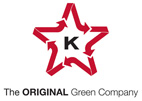Production Process
Keyes utilizes an efficient, sustainable process to produce its molded fibre packaging. By using local material and energy, we are able to save literally tons of waste product and substantial amounts of energy and water (see our sustainability section for more details). Our process is an efficient and fluid workflow from start to finish. The visualization below outlines the steps from reclamation of recycled paper stock to finished product.
Trucks deliver bales of recycled paper and cardboard.
In the mixer we blend the stock paper, add water, and remove non-fibrous materials.
Holding tanks further clean the slurry.
Food-safe dye colors are added to the slurry.
Machines pull the slurry mix onto molds and remove water to form product. Water is reused.
Trays are transported to the drying process.
Dryer uses natural gas to heat and evaporate water from trays.
Finished trays are stacked, palletized, wrapped and loaded for delivery.

Once mixed, contaminants and non-fiber materials are removed, and the slurry moves on
to the next phase of the process, where it is prepared for molding.

After the trays are molded, they are quickly transferred to the drying ovens
where heat drives off the water, resulting in a finished product.

Inside the Factory
Our factory was constructed in the 1950s and is still working at full capacity today. We continue to innovate upon our process and equipment, but the overall process is still the same as that which Martin L. Keyes developed in the early 1900s. It is impressive to watch as rough scraps of recycled content move through the process and turn into clean, soft packaging materials.
 Newly delivered recycled paper ready to be pulped
Newly delivered recycled paper ready to be pulped
 Holding tanks clean the blended pulp to remove non-fiber components.
Holding tanks clean the blended pulp to remove non-fiber components.
 Finished dry trays exit the oven
Finished dry trays exit the oven
 Bundled trays are palletized and ready to be wrapped
Bundled trays are palletized and ready to be wrapped
 The finished product is ready to be loaded and delivered
The finished product is ready to be loaded and delivered

